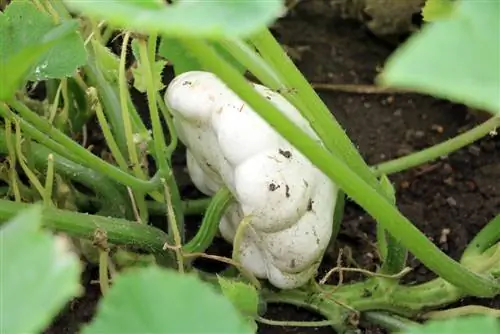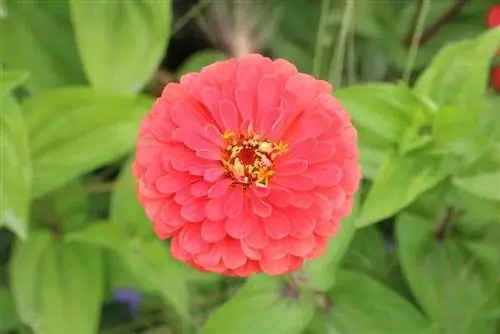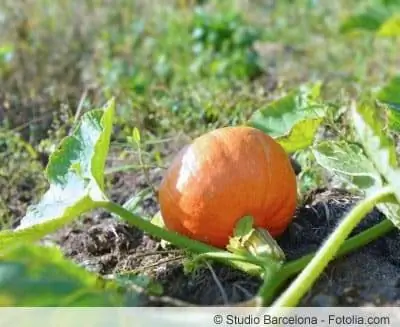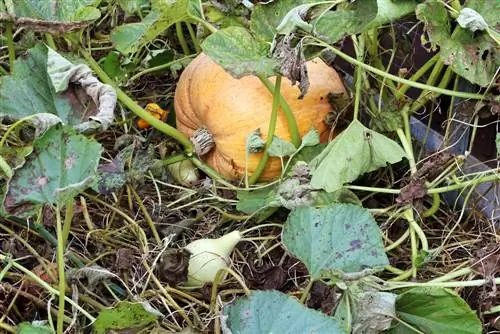- Author admin [email protected].
- Public 2023-12-17 03:39.
- Last modified 2025-01-24 12:45.
Pumpkins begin to bloom about four weeks after germination. Depending on the variety and the prevailing weather, it takes between 60 and 150 days from sowing to harvest. A second plant is not necessarily necessary for pollination, as a pumpkin plant produces both male and female flowers on a single plant. However, the male flowers are very small and inconspicuous. The female flowers have an ovary at their base, which already has the final shape of the pumpkin fruit.
Profile
- Botanical name: Cucurbita
- belongs to the cucurbit family
- one of the oldest fruit vegetables
- other names: Kerbes, Kirbes, Flaske
- Flowers: bell-shaped, strong yellow color (June to August)
- Fruit: mostly large orange, whitish or green fruits in different shapes
- Harvest: between September and October
The most popular types of pumpkin
The pumpkin has its origins in Central America. Since then, the pumpkin has spread all over the world and is now cultivated in our gardens with around 15 species and numerous varieties. Like the smaller ornamental pumpkins, pumpkins are annual plants that grow lying on the ground or climbing. The shoots can reach lengths of up to ten meters. Both the thick stems and the large heart-shaped leaves are covered with stiff hairs. There are around 200 different varieties of pumpkins available commercially. The most popular varieties are:
Hokkaido (Uchiki Kuri)
- round shape
- orange-red peel
- Weight: 0.5-3kg
- Flesh yellow-orange
- floury to dry, slightly sweet, nutty
- does not need to be peeled for cooking
- Use as a soup or side dish (edible raw)
- can be stored for several months
Butternut (Butternut)
- elongated, slightly dumbbell-like shape
- beige bowl
- Weight: 1-3 kg
- yellow-orange, firm flesh
- nutty-sweet taste
- few cores
- Use: for baking (can also be eaten raw)
- can be stored over the winter
Spaghetti Squash
- oval shape
- yellow bowl
- Weight: up to 3 kg
- nutty aroma
- Flesh breaks down into strands (spaghetti) when cooked
- Use: salad, for frying, soups, puree, baking
Red Hundredweight
- ribbed, flat-round shape
- red bowl
- Weight: 5-7 kg
- watery pulp, aromatic
- Use: as vegetables or jam
Nutmeg (Muscade de Provence)
- heavily ribbed, flat-round shape
- green bowl
- Weight: 4-20 kg
- orange pulp
- very aromatic
- Use: Soup, for pickling, jam
- stores well
Langer of Naples (Lunga di Napoli)
- green stick pumpkin
- strong orange flesh
- Weight: 5-25 kg (length up to over one meter)
- very few cores
- Use: sweet dishes, soups, savory foods
- long lasting

Patisson (UFO)
- white or yellow-green peel
- Summer squash
- white, firm pulp
- Weight: 0.5-1.5kg
- Use: stuffed or cut into slices (breaded as schnitzel or for grilling)
- Storage period 2-3 months
Location
In order to produce large fruits, a pumpkin needs humus-rich soil. Some gardeners swear by growing their squash in a compost pile. This has two decisive advantages: on the one hand, the plant receives sufficient nutrients, on the other hand, the compost is visually improved and also receives shade in summer.
- Light requirement: sunny
- Soil: humus, good water storage capacity
- in the vegetable patch or on the compost
- very high space requirement
Growing from seeds
Pre-grown pumpkin plants can be purchased in some nurseries in May. But it's not difficult to grow your own pumpkin from seeds.
- Sowing: from the end of March in the apartment
- Substrate: potting soil
- place bright and warm (no direct sun)
- always keep slightly moist (not wet!)
Tip:
Since the pumpkin plants are sensitive to frost, they should not be planted outdoors until May at the earliest, after the Ice Saints. Exceptions are cold frames or greenhouses.
Plants
All varieties of squash require high amounts of nitrogen in the soil. If they are planted in the bed, it is a good idea to mix a little shredded manure into the soil in the fall of the previous year.
- maintain a planting distance of at least five meters for large varieties
- For smaller varieties (like Hokkaido), about two meters of planting distance is sufficient
- sensitive to viral diseases, so it is better to plant alone
- Combination with cucumbers and zucchini no problem
Tip:
Actually, the compost is too rich in humus for cultivating the pumpkin and the pumpkin “shoots up”. It is better to mix the compost with a thick layer of soil or to place the pumpkin slightly to the side.
Pouring
A pumpkin needs a lot of water to form the long shoots and large fruits. That's why the plant needs to be watered regularly right from the start. However, pumpkins, like cucumbers, are sensitive to waterlogging and moisture on the leaves. It is therefore advisable to pour the irrigation water directly onto the floor, otherwise mold, mildew or rot can occur.
Fertilize
Organic fertilizers are better for a pumpkin than mineral fertilizers. Adding compost or horn shavings to the bed when planting can support growth and fruit formation. If the pumpkin is on the compost or the bed was supplied with manure the previous year, no further fertilizer is necessary.
Care
Apart from a good supply of water, a pumpkin is very easy to care for. If the plant grows too strongly, it can easily be cut back a little. The first flower forms quickly and a small fruit often appears on the pumpkin plant after a very short time. Even if it is difficult, the first flower or fruit that is close to the root should be carefully removed. This means the plant can better invest its energy in the other fruits. If it is important to harvest particularly large pumpkins, the following procedure is recommended:
- leave two to three fruits close to the base
- Only cut off further tendrils when tennis ball-sized fruits are already visible
- leave two leaves after the last remaining pumpkin
For very large pumpkins, it is a good idea to place a wooden board underneath so that they do not rest on the damp earth and rot.
Tip:
Of course, the pumpkin plant can also simply be left to its own devices. Then there are simply lots of smaller pumpkins to harvest.
Harvest
Depending on the climatic conditions, the pumpkins are ripe and can be harvested from September to October. The best way to tell when pumpkins are ripe is that the leaves of the plant slowly die back. Stored cool but frost-free, many varieties last throughout the winter.
Tip:
Ripe pumpkin sounds hollow when you tap on it. When storing, avoid direct proximity to apples and pears!
Conclusion
Pumpkins come in many colors, shapes and sizes. In addition to a high nutrient content in the soil (especially nitrogen), the plants only need sun and a lot of water to produce impressive fruits that are used in many different ways in the kitchen. Pumpkins don't like two things: waterlogging and dark locations. If leaves or roots get wet for a long time, the plant will quickly rot or become susceptible to powdery mildew. If the plant is too dark, no fruits will form.
What you should know about pumpkin soon
Cultivation
- The foliage, roots and fruits of a pumpkin can only develop properly if the appropriate planting distance is maintained.
- Pumpkin plants prefer a sunny location. The soil should consist of humus-rich soil or compost soil.
- Pumpkin plants do not tolerate waterlogging and should therefore be watered moderately but regularly.
- Since pumpkins need nutrients such as potassium and phosphorus, the plants' location should be changed every two to three years.
Sowing
- The pumpkin seeds can be sown directly in the outdoor bed from mid-May.
- To protect the seeds from birds and snails, they can also be grown in pots.
- Prowning in pots also speeds up the harvest by three to four weeks. Both seed variants have their advantages and disadvantages.
- By moving the early plants, the seedlings get into a stressful situation, which leads to a temporary stop in growth.
- The plants are placed in the outdoor bed when they have developed two to three leaves.
- The seedling is buried sufficiently deep so that the stem can form new roots.
- Pumpkin plants are not watered from above, but directly on the rootstock, as they are very susceptible to mildew.
- The seedling is now growing daily and will soon bear flowers.
Harvest
- When harvesting, care must be taken to avoid injuries to the pumpkin shell. Injuries shorten the shelf life of plants.
- The fruit stalk should not be broken off, as this area will then begin to rot.
- It is advisable to store pumpkins for around two weeks after harvesting so that they continue to ripen.
- This can be done in cool and dry rooms at a temperature of 10 to 13 °C. Pumpkins generally cannot tolerate temperatures below zero.
- Sliced pumpkin pieces should be eaten within three to four days, during which time they should be kept cool.
- Pumpkins can be eaten raw or cooked.
- For young pumpkins and summer squash, the peel can also be cooked in most cases.
- The Hubbard and Musk varieties, on the other hand, have a very hard shell that cannot be cooked.
- Pumpkins can be prepared in a variety of ways. You can boil, bake, grill or steam them.
Tip:
Pumpkin seeds can also be used culinary. To do this, dry and peel the kernels, sprinkle them with a little cooking oil and put them in the oven at 180 degrees Celsius for 30 minutes. After cooling, the roasted pumpkin seeds can be stored in a closed container.






